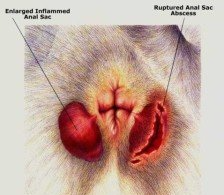Impacted Anal Sacs

What Are Anal Sacs?
Anal sacs are a set of glands that are just under the skin near your pet’s anus. The two oval shape sacs are located at the 4 and 8 o’clock positions just on either side of the anus. The anal sacs fill with a foul-smelling fluid that is normally expressed through a tiny duct when animals pass stools. Animals may use their anal glands to mark territory or repel aggressors, although a nervous dog or cat may accidentally express these glands when frightened.
When an animal cannot naturally empty their anal sacs during defecation, fluid gradually accumulates within the sac, causing it to become increasingly swollen. This is called an impacted anal sac, which can become painful and irritating to the animal. Some pets drag or “scoot” on their rear end to try to relieve pain and empty the glands. Pets may also lick the area to relieve discomfort.
If impacted anal sacs are not emptied, they continue to swell with fluid, leading to inflammation. Eventually, the area becomes infected, and an abscess (pus) can form. In some cases, the abscess can rupture through the skin. This condition can be extremely painful to the pet and requires immediate medical treatment. In some cases, particularly if the problem happens several times to the same animal, surgical management of the anal gland disease may be recommended.
Signs of Impacted Anal Glands
- Scooting on their bottoms
- Licking, chewing, or “chasing” the anal area
- A foul odour around the anal area
- Straining to defecate
- Pain during defecation
- Swelling or bleeding around the anus

Remember that every animal is different and thus may not always exhibit any or a combination of the signs listed above. If you are concerned that your pet may have an impacted anal gland, it is best that you seek advice from your veterinarian.
Diagnosis
Your veterinarian can diagnose many anal gland issues by examining the area and perform a rectal exam to evaluate the anal glands. For pets that are in a lot of pain, sedation may be recommended so that a thorough rectal examination can be performed. During the examination, your veterinarian will look for redness, signs of pain, swelling, or the presence of pus, which indicates infection. If there is an abnormal thickening, lump/s, or growth/s within the anal gland, your veterinarian may also recommend a biopsy (collecting and testing a small sample of tissue) to help determine whether the tissue is cancerous.
Treatment
Expressing the anal sacs describes the manual removal of fluid that has accumulated in the anal glands. This can be performed at the vet clinic. Sometimes if the pet is in too much discomfort, your veterinarian may recommend sedation to express the impacted anal sacs. If the anal glands are infected or abscessated, your veterinarian may need to flush out the sacs with an antiseptic solution and/or insert an antibiotic ointment to relieve pain and inflammation. Oral antibiotics, pain relief, and anti-inflammatory medications may also be prescribed.
Surgical removal of the anal glands may be recommended for animals that have had repeated anal gland issues or infections. Your veterinarian will talk to you about the benefits and risks of this procedure and whether it may be a good option for your pet.
Prevention
The best way to prevent anal sac issues is to frequently express the anal sacs if they are not emptying on their own. This may be done by a veterinarian or a veterinary nurse. This helps prevent the sacs from over-filling with fluid. Some experts recommend adding fibre to the pet's diet, which helps make the stools “bulky” thereby encouraging the anal sacs to empty at time of defecation.



